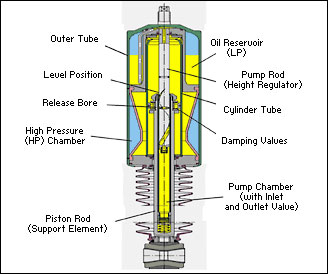Technical Curiosities: Nivomat Dampers

Editor’s note: As a point of clarification, I will be using the more technically correct term “dampers” to refer to what are normally, but misleadingly, described as “shock absorbers.”
Fitted prominently to the Volvo 760 sedan and 780 coupe, among many others including Rovers, Opels and Mitsubishis, Nivomat dampers should be more well known. But they seem to remain an obscure detail uncovered only by new owners of cars fitted with the system, and then usually only when it fails.

A combination of the French words niveau (level) and automatique, Nivomat dampers combine the function of the car-supporting spring and damper into one self-contained unit. As a result, they can be a source of particular frustration when they go bad, since the whole unit must be replaced, unlike a conventional suspension which isolates failure to either the spring (uncommon) or damper (more common). Not only that, Nivomat dampers’ relative rarity compounds the challenge by making parts that much more difficult to source and expensive.
Does the Nivomat system have any redeeming qualities? Absolutely; as mentioned, the units combine springs and dampers, but more than that, as implied by the name, they automatically level the car regardless of the load conditions. No more sagging rear end when the back seat and trunk are fully loaded—the Nivomats’ internal pressure rises to compensate and restore the normal ride height. It’s worth noting, as well, that most, if not all applications fitted the system only to the rear wheels, leaving the fronts with a conventional spring-and-damper setup.

The Nivomat system is hardly the only self-leveling suspension (SLS) on the market—BMW and Mercedes, just to name two, developed their own SLS systems—but what truly sets it apart is its completely self-contained design. Where other SLS systems require a support network of pumps, lines and valves, raising the part count and drawing (an admittedly small amount of) power from the engine, a Nivomat damper has an internal pump and relies on car’s normal up-and-down suspension movement as it drives for the energy needed to operate, much like a self-winding watch depends for its power on the movement of the wearer’s arm. It’s a remarkably clever design that harnesses what would other be wasted energy in service of a useful function.
Sadly, as widespread as they were, Nivomat dampers never really became mainstream. The system persisted for 20+ years, but modern electronic suspension setups eventually eclipsed the Nivomat system’s mechanical novelty.
Image credits: netcarshow.com, wardsauto.com, ipdusa.com
Editor’s note: This post is part of an ongoing series spotlighting obscure automotive engineering solutions. Read the other installments here:

Interesting article on a clever design. Reminds me of one of the Wolfpack Motorsports guys from college who did his masters degree on a control system for magnetorheological dampers for racing applications. That tech was (and probably is?) used on Cadillacs and other performance vehicles to lend infinite and instantaneous damping adjustments.
Really cool. It’d be interesting to see if there are any connections there… By all accounts the electronically-controlled suspension (well, and the engine) is the key to the McLaren MP4-12C’s performance, and many other cars’.